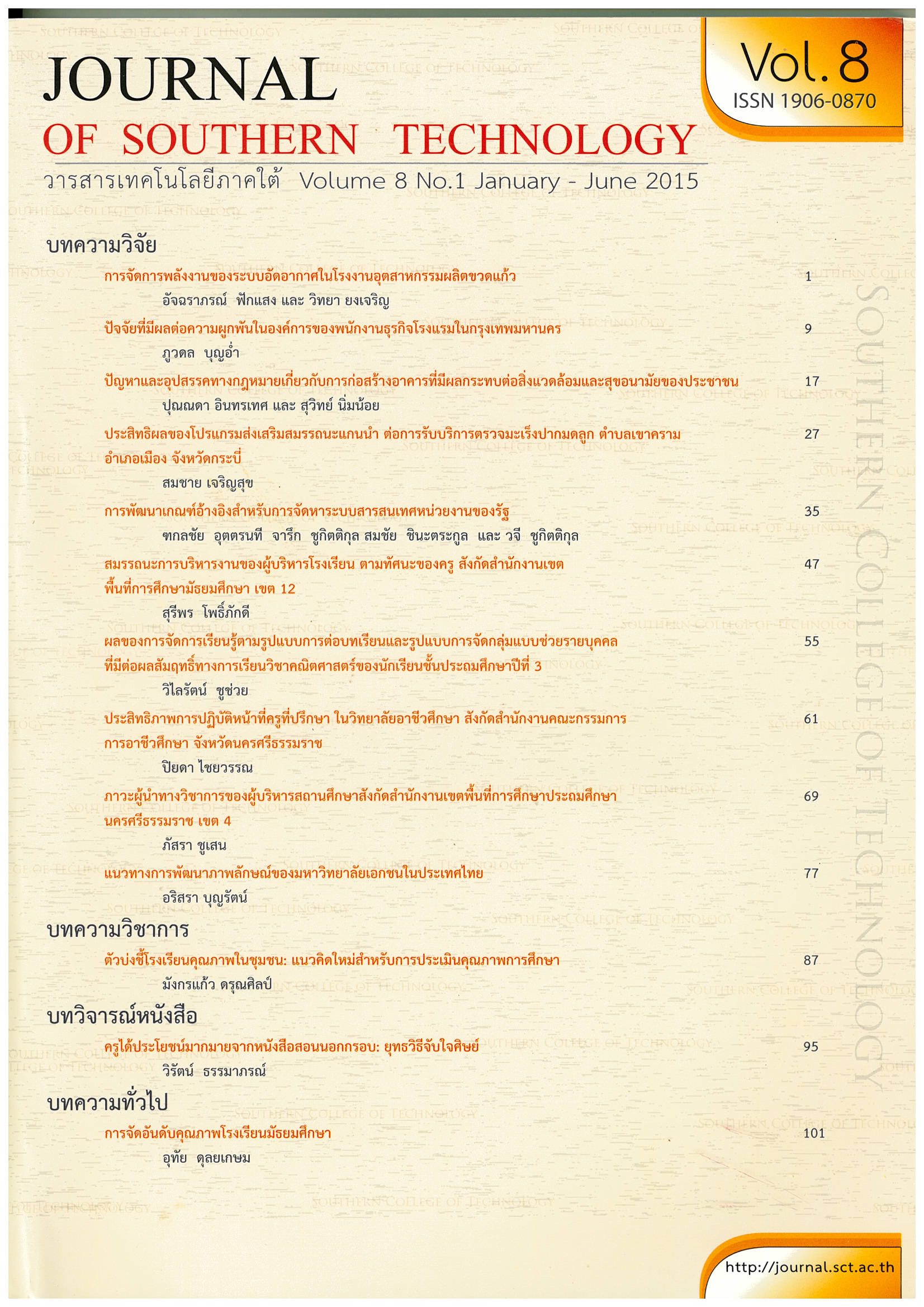แนวทางการพัฒนาภาพลักษณ์ของมหาวิทยาลัยเอกชนในประเทศไทย
Main Article Content
Abstract
การวิจัยครั้งนี้มีวัตถุประสงค์เพื่อหาองค์ประกอบ ภาพลักษณ์ของมหาวิทยาลัยเอกชนในประเทศไทย และ แนวทาวทางการพัฒนาภาพลักษณ์ ของมหาวิทยาลัยเอกชนในประเทศไทย การดำเนินการวิจัยแบ่งเป็น 3 ระยะ คือ ระยะที่ 1 สังเคราะห์ภาพลักษณ์ ของมหาวิทยาลัยเอกชนในประเทศไทย จากแนวคิด ทฤษฎี และการสัมภาษณ์ผู้เชี่ยวชาญ เกี่ยวกับภาพลักษณ์ของมหาวิทยาลัยเอกชนในประเทศไทย ระยะที่ 2 การวิเคราะห์องค์ประกอบเชิงสำรวจ เพื่อหาองค์ประกอบภาพลักษณ์ จากกลุ่มตัวอย่าง ผู้บริหารและบุคลากรที่ดำเนินงานเกี่ยวกับภาพลักษณ์ของมหาวิทยาลัยเอกชนในประเทศไทย จำนวน 40 แห่ง รวมทั้งสิ้น 200 คน และระยะที่ 3 ศึกษาแนวทางการพัฒนาภาพลักษณ์ ของมหาวิทยาลัยเอกชนในประเทศไทย จากการสัมภาษณ์เชิงลึกผู้เชี่ยวชาญ จำนวน 7 คน
ผลการวิจัยพบว่า องค์ประกอบภาพลักษณ์ของมหาวิทยาลัยเอกชนในประเทศไทย ประกอบด้วย 5 องค์ประกอบ ดังนี้ (1) ด้านนวัตกรรมของหลักสูตร (2) ด้านความรับผิดชอบต่อสังคม (3) ด้านความคุ้มค่าทางวิชาการ (4) ด้านคุณภาพบัณฑิต และ (5) ด้านความเป็นนานาชาติ โดยมีแนวทางการพัฒนาภาพลักษณ์ ดังนี้ ด้านนวัตกรรมของหลักสูตร ควรจัดตามสภาพจริง บริบท และอัตลักษณ์ของมหาวิทยาลัย โดยเมื่อผู้เรียนสำเร็จการศึกษาไปแล้ว สามารถนำไปต่อยอดหรือศึกษาต่อในระดับที่สูงขึ้นได้ ด้านความรับผิดชอบต่อสังคม มหาวิทยาลัยต้องผลิตผลงานวิจัย เพื่อนำองค์ความรู้ใหม่ ๆ ไปพัฒนาชุมชนรอบ ๆ มหาวิทยาลัย และจัดการเรียนการสอนที่มีคุณภาพเพื่อบัณฑิตที่จบออกไปมีคุณภาพ ไม่เป็นภาระต่อสังคม ด้านความคุ้มค่าทางวิชาการ พัฒนาศักยภาพของอาจารย์ตามศาสตร์ที่ถนัด ทั้งการศึกษาต่อในระดับที่สูงขึ้น การเข้าร่วมอบรมสัมมนาต่าง ๆ เพื่อนำความรู้มาพัฒนาผู้เรียนต่อไป เพราะเด็กจะเก่งได้ต้องมีครูที่ดีและเก่งด้วย ด้านคุณภาพบัณฑิต การส่งเสริมทักษะทางวิชาชีพตั้งแต่ต้นในการเรียน เพื่อให้บัณฑิตสามารถปรับตัวในการทำงาน แก้ไขปัญหาเฉพาะหน้าได้จริง เมื่อออกไปสู่ตลาดแรงงาน และด้านความเป็นนานาชาติ ส่งเสริมทุนการศึกษา แลกเปลี่ยนทั้งบุคลากรและนักศึกษา ระหว่างมหาวิทยาลัยไทยและต่างชาติ โดยทำความร่วมมือทางวิชาการกับมหาวิทยาลัยต่างชาติที่มีชื่อเสียง
Approaches to Development of Thai Private University Images
This research aimed to identify components, images as well as approaches to develop images of private universities in Thailand. It consisted of three phases. In the first phase, theories reviewed from literature and information obtained from interviews with specialists concerning Thai university images were synthesized. The second phase involved survey analysis on components of the images obtained from a sample of 200 individuals. They included administrators and staff who were responsible for Thai private university images from 40 offices. In the last phase, approaches to develop the images were examined through interviews with seven experts. It was found that the images composed of five components: curriculum innovation, social responsibility, academic worthiness, graduate quality, and internationalization. As for the approaches for each component, it was suggested that curriculum innovation should be authentic in the way that graduates can further develop in the future. To show social responsibility, the universities must research that can be applied for community development. Furthermore, they should ensure quality education students receive so that they can get jobs after graduation as to avoid social burden. In
addition, lecturers should be promoted to develop their potentials such as pursuing higher education, joining seminars and trainings which in turn will also develop their learners through application of the new knowledge acquired. Next, professional skills should be established among students from the beginning of their education years as to instill in them as well as problem-solving skills necessary at work for their future. Finally, internalization of the universities can be developed through offering scholarships to both staff and students, having student and teacher exchange programs between local and international universities, and promoting academic cooperation with recognized universities overseas.
Article Details
-
Authors must agree to the journal publication rules and allow the editors to edit the manuscripts for publication.
-
Author’s right belongs to the author but Journal of Southern Technology holds the right of first publication and thus allow readers to use the article for the purpose of education but not commercial.

